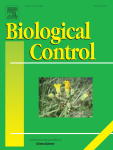Ver ítem
- xmlui.general.dspace_homeCentros Regionales y EEAsCentro Regional Patagonia NorteEEA BarilocheArtículos científicosxmlui.ArtifactBrowser.ItemViewer.trail
- Inicio
- Centros Regionales y EEAs
- Centro Regional Patagonia Norte
- EEA Bariloche
- Artículos científicos
- Ver ítem
Effects of elevated CO2 on the water hyacinth-biocontrol agent Megamelus scutellaris (Hemiptera: Delphacidae) and its yeast-like symbiotes
Resumen
Water hyacinth, Pontederia crassipes, is a highly invasive plant native to South America and one of the most invasive aquatic plants in the world. For its control, the planthopper Megamelus scutellaris Berg (Hemiptera: Delphacidae), a phloem feeder also native to South America has been introduced to the USA and South Africa. Considering predicted climate change scenarios, understanding their impacts on biological control agents is crucial. An intriguing
[ver mas...]
Water hyacinth, Pontederia crassipes, is a highly invasive plant native to South America and one of the most invasive aquatic plants in the world. For its control, the planthopper Megamelus scutellaris Berg (Hemiptera: Delphacidae), a phloem feeder also native to South America has been introduced to the USA and South Africa. Considering predicted climate change scenarios, understanding their impacts on biological control agents is crucial. An intriguing yet scarcely explored subject, is the effect of climatic changes on the obligate endosymbionts associated with sap-sucking feeders. Planthoppers establish an obligate relationship with yeast-like symbiotes (YLS), unicellular fungal microorganisms that play an important role in their development, providing missing nutrients in their diet. Considering that increased atmospheric CO2 affects plant chemical composition, this might have a direct impact on their insect host and on their number of YLS. We evaluated the effect of two different CO2 environments: current (cCO2 − 400 ppm) and elevated (eCO2 − 800 ppm) on the abundance of YLS (number of YLS cells/insect) of M. scutellaris, as well as the, age structure, sex, and weight of insects. Heavier females harbored more YLS under eCO2 which underscores the importance of the interaction of CO2 levels and insects’ weight in shaping the abundance of YLS. Additionally, there was a significant increase in the total abundance of insects for instars III to V and adults under eCO2 conditions. However, male number significantly exceeded that of females under both CO2 conditions. Our results suggest a potential positive impact of eCO2 on M. scutellaris populations, which could, in turn, enhance the control of P. crassipes.
[Cerrar]

Autor
Righetti, Tomás;
Fuente, Daniela de la;
Paper, Matthew K.;
Brentassi, María E.;
Hill, Martin P.;
Coetzee, Julie A.;
Salinas, Nicolás A.;
Bruzzone, Octavio Augusto;
Sosa, Alejandro Joaquin;
Fuente
Biological Control 188 : 105433. (January 2024)
Fecha
2024-01
Editorial
Elsevier
ISSN
1049-9644
1090-2112
1090-2112
Formato
pdf
Tipo de documento
artículo
Palabras Claves
Derechos de acceso
Abierto
 Excepto donde se diga explicitamente, este item se publica bajo la siguiente descripción: Creative Commons Attribution-NonCommercial-ShareAlike 2.5 Unported (CC BY-NC-SA 2.5)
Excepto donde se diga explicitamente, este item se publica bajo la siguiente descripción: Creative Commons Attribution-NonCommercial-ShareAlike 2.5 Unported (CC BY-NC-SA 2.5)


